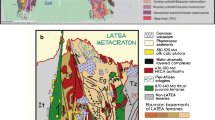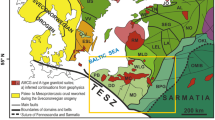Abstract
The Nuweibi albite granite is one of 14 known Sn-Ta-Nb bearing granitoids in the Eastern Desert region of Egypt. The granite is a highly leucocratic, albite-rich rock with accessory columbite-tantalite, cassiterite, microlite and ixiolite as well as topaz, garnet and white mica. Ages of 450–600 Ma were obtained from zircons by the 207Pb/206Pb evaporation method. Great uncertainty is caused by the small size and poor quality of the grains, but the precision is sufficient to indicate that the granite is late- or postorogenic with respect to the Panafrican orogeny. The Nuweibi granite is divided into a western and an eastern part by a regional fault. Both parts of the granite are compositionally similar but there are important differences and a clear compositional gap between them, so they are considered separate facies of an intrusive complex. The eastern part of the granite is more highly mineralized, has higher modal albite contents and higher Ta/Nb ratios, both in the whole rock and in the ore minerals. It is suggested that the two parts of the granite evolved from a common source and were emplaced sequentially, the eastern part representing a later, more fractionated magma. Textural evidence strongly suggests that the granite has a magmatic origin overall, but disturbance of geochemical trends at the whole-rock scale and at the scale of zoning profiles in individual grains of columbite-tantalite indicate post-magmatic overprinting. By analogy with other Ta-bearing albite granites, the sodic bulk composition of the Nuweibi granite can be explained by fluorine enrichment in the magma. Fluorine contents in the magma were high enough to stabilize topaz, and muscovites contain 2–4 wt.%. F. However, whole-rock F contents are low. We speculate that the low Ca, Al and P contents of the magma prevented abundant F-bearing minerals to form and led to loss of fluorine to now-eroded roof rocks.
Similar content being viewed by others
Author information
Authors and Affiliations
Additional information
Received: 8 November 1995 / Accepted: 10 June 1996
Rights and permissions
About this article
Cite this article
Helba, H., Trumbull, R., Morteani, G. et al. Geochemical and petrographic studies of Ta mineralization in the Nuweibi albite granite complex, Eastern Desert, Egypt. Mineral. Deposita 32, 164–179 (1997). https://doi.org/10.1007/s001260050082
Issue Date:
DOI: https://doi.org/10.1007/s001260050082




